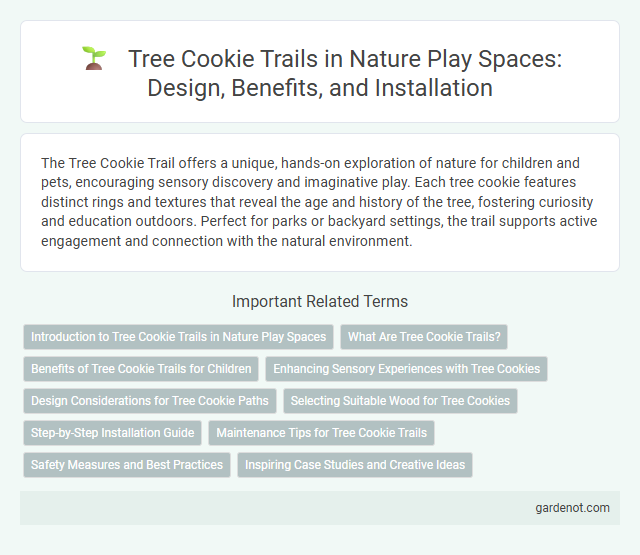The Tree Cookie Trail offers a unique, hands-on exploration of nature for children and pets, encouraging sensory discovery and imaginative play. Each tree cookie features distinct rings and textures that reveal the age and history of the tree, fostering curiosity and education outdoors. Perfect for parks or backyard settings, the trail supports active engagement and connection with the natural environment.
Introduction to Tree Cookie Trails in Nature Play Spaces
Tree cookie trails in nature play spaces offer children tactile and visual experiences by showcasing cross-sections of tree trunks that reveal growth rings and wood patterns. These trails encourage exploration and learning about tree age, species, and environmental history through interactive, natural materials. Incorporating tree cookie trails promotes sensory engagement and environmental education within outdoor play areas.
What Are Tree Cookie Trails?
Tree cookie trails are educational paths made up of cross-sections of tree trunks, known as tree cookies, arranged sequentially to showcase different tree species and their growth rings. These trails offer a hands-on learning experience that helps children and nature enthusiasts understand tree age, growth patterns, and ecological history through visual and tactile exploration. By examining the varying sizes and textures of each cookie, participants gain insight into forest ecology, seasonal changes, and environmental impacts on tree development.
Benefits of Tree Cookie Trails for Children
Tree cookie trails enhance children's sensory exploration and fine motor skills by encouraging hands-on interaction with natural wood slices. These trails foster cognitive development through pattern recognition and sequencing activities, promoting early math and observational abilities. Exposure to natural textures and organic shapes supports emotional well-being and a deeper connection to the environment, making tree cookie trails an effective educational tool in outdoor learning spaces.
Enhancing Sensory Experiences with Tree Cookies
Tree cookies, cross-sections of tree trunks, offer rich sensory experiences by revealing unique growth rings and varied textures that engage touch and sight. Their distinct patterns allow children to explore natural history while enhancing observational skills and fine motor development. Incorporating tree cookies into nature play promotes tactile learning and deepens connection to the environment.
Design Considerations for Tree Cookie Paths
Tree cookie paths require careful design considerations such as selecting durable wood species resistant to weather and decay, ensuring slices are evenly cut to maintain a consistent walking surface, and securely anchoring each cookie to prevent shifting or tripping hazards. Incorporating varied sizes and natural textures enhances sensory engagement while maintaining accessibility for children of different ages and abilities. Proper spacing and integration with surrounding natural elements support safe navigation and encourage exploration along the trail.
Selecting Suitable Wood for Tree Cookies
Selecting suitable wood for tree cookies involves choosing hardwood species like oak, maple, or cherry due to their dense grain and durability, which ensure long-lasting play materials. Avoid softwoods or resinous trees such as pine, as they can be prone to cracking and decay when exposed to outdoor elements. Properly seasoned and untreated wood improves the safety and longevity of tree cookies, making them ideal for tactile and educational nature play experiences.
Step-by-Step Installation Guide
Tree cookie trails enhance nature play by creating interactive pathways using cross-sections of tree trunks. Begin by selecting durable, evenly sized tree cookies, sanding each surface to prevent splinters and improve safety. Securely anchor the cookies into the ground at regular intervals using rebar or wooden pegs to ensure stability and create a safe, engaging trail for children to explore nature through tactile and visual learning.
Maintenance Tips for Tree Cookie Trails
Regularly inspect tree cookies for signs of mold or insect infestation to ensure safety and longevity. Clean the surfaces with mild soap and water, avoiding harsh chemicals that could damage the wood's natural texture. Apply a non-toxic sealant periodically to protect the wood from moisture and weathering, enhancing the trail's durability in outdoor environments.
Safety Measures and Best Practices
Tree cookie trails promote safe interaction with nature by encouraging children to stay on designated paths, reducing the risk of trips and falls. Regular inspection and maintenance of tree cookies ensure smooth surfaces free from splinters or sharp edges, enhancing safety. Clear signage and adult supervision further support best practices, creating a secure, engaging outdoor learning environment.
Inspiring Case Studies and Creative Ideas
Tree cookie trails provide immersive nature play experiences by integrating cross-sections of tree trunks to educate children about tree rings, growth patterns, and ecological systems. Creative installations incorporate painted or carved designs on tree cookies, sparking curiosity and storytelling, while case studies reveal enhanced outdoor learning and increased engagement in environmental stewardship among visitors. Innovative use of digital apps paired with tree cookie trails amplifies interactive exploration, offering personalized educational content and fostering deeper connections to nature.
Tree cookie trail Infographic

 gardenot.com
gardenot.com